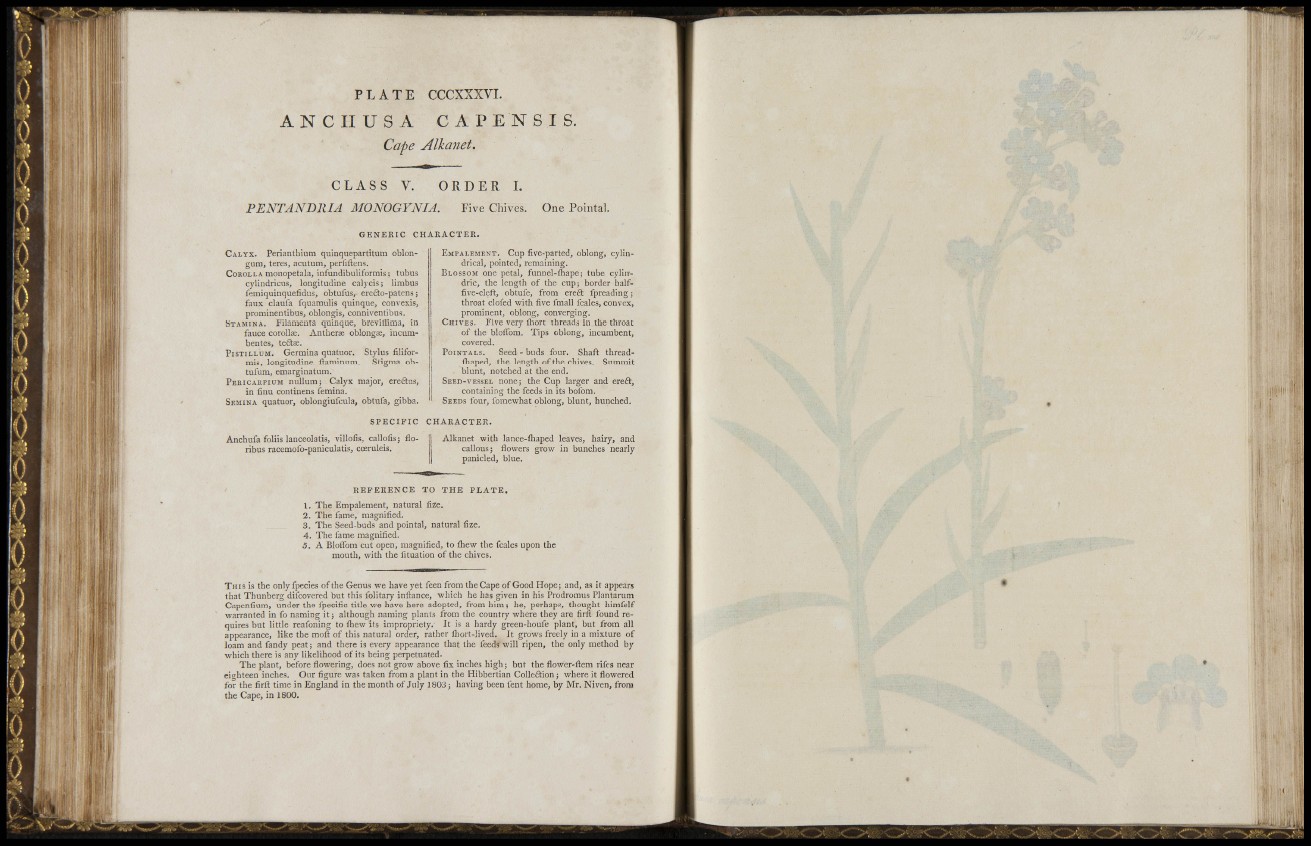
I ' 1"
i 1 .; 1
P L A T E CCCXXXVI.
A N C II U S A CA P E N SIS.
Cape Alkanet.
C L A S S V. ORDER L
PENTANDRIA MONOGYNIA. Five Chives. One Pointal.
GENERIC CHAKACTER.
CALYX. Perianthium quinquepartitum oblongura,
teres, aeutum, perliftens.
COROLLA monopetala, infundibuliformis: tubus
cylindriciis, longitudine caljcis; limbus
femiquinquefidus, obtufus, erefilo-patens ;
faux claufa fquamulis quinque, convexis,
promiuentibus, oblongis, conniventibus.
S T A M I N A . Filamenta quinque, breviffima, in
fauce corollae. Antherae oblongoe, incumbentes,
teilae.
PisTiLLUM. Germina quatuor. Stylus filiformis,
longitudine ftaminum. Stigma obtufum,
emarginatum.
PEKiCAKPiaM nullum; Calyx major, ereitus,
in linu continens femina.
SEMIN A quatuor, oblongiufcula, obtufa, gibba.
EMPALEMENT. Cup five-parted, oblong, cylindrical,
pointed, remaining.
BLOSSOM one petal, funnel-iliape; tube cylindric,
the length of the cup; border halffive
cleft, obtufe, from ereft fpreading ;
throat doled with five fmall fcales, couvex,
prominent, oblong, converging.
CHIVES. Five very fliort threads in the throat
of the blolTom. Tips cblong, incumbent,
covered.
PoiNTALs. Seed - buds four. Shaft threadihaped,
the length of the chives. Summit
blunt, notched at the end.
SEED-VESSEL none; the Cup larger and ereâ,
containing the feeds in its bofom.
SEEDS four, fomewhat oblong, blunt, hunched.
S P E C I F I C CHARACTER.
Anchufa foliis lanceolatis, villofis, callofis; fioribus
racemofo-paniculatis, coeruleis.
Alkanet with lance-fliaped leaves, hairy, and
callous; flowers grow in bunches nearly
panicled, blue.
REFERENCE TO THE PLATE.
1. The Empalement, natural fize.
2. The fame, magnified.
3. The Seed-buds and pointal, natural fize.
4. The fame magnified.
5. A BlolTom cut open, magnified, to ihew the fcales upon the
mouth, with the fituation of the chives.
T H I S is the only fpecies of the Genus we have yet feen from the Cape of Good Hope; and, as it appears
that Thunberg difcovered but this folitary inftance, which he has given in his Prodromus Plantarum
Capenfium, under the fpecific title we have here adopted, from him; he, perhaps, thought himfelf
warranted in fo naming it; although naming plants from the country where they are firil found requires
but little reafoning to fliew its impropriety. It is a hardy green-houfe plant, but from all
appearance, like tbe moil of this natural order, rather fliort-lived. It grows freely in a mixture of
loam and fandy peat; and there is every appearance that the feeds will ripen, the only method by
which there is any likelihood of its being perpetuated.
The plant, before flowering, does not grow above fix inches high; but the flower-ftem rifes near
eighteen inches. Our figure was taken from a plant in the Hibbertian Colle£tion; where it flowered
for the firft time in England in the month of July 1803; having been fent home, by Mr. Niven, from
the Cape, in 1800.
K, :(